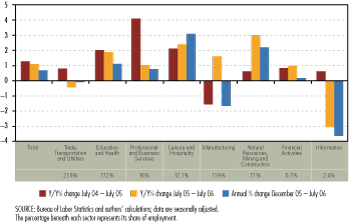District Overview: Slow and Steady in St. Louis
Employment in the St. Louis metro area grew slightly more slowly during the 12 months ending in July 2006 than it did during the preceding 12-month period.1 Despite slowing, employment growth remained positive over the first seven months of 2006. The overall employment picture clouds a great deal of variation across sectors. In addition, other indicators suggest that the St. Louis economy is performing better than is indicated by the employment numbers.
The figure provides three different growth rates for total private nonfarm employment and for employment in eight sectors. The three growth rates are: percent change over the period July 2004-July 2005, percent change over the period July 2005-July 2006 and the annualized growth rate for the first seven months of 2006. The sectors are ordered by size, and their shares of the total as of July 2006 appear under the sector names.
From July 2005 to July 2006, employment in St. Louis grew by 1.1 percent, which was slightly smaller than the previous year’s growth. In terms of the number of jobs, the July 2006 estimate indicated that the St. Louis metro area produced a net gain of about 12,900 private nonfarm jobs in the previous 12 months. This performance was slightly worse than what was seen at the national level: The analogous employment growth rate for the United States was just over 1.4 percent.
Six of the eight private sectors contributed positively to the employment growth in the year beginning in July 2005. The largest sector—trade, transportation and utilities—experienced a slight decrease in employment of one-half of a percent since July 2005, although its performance was nearly flat in the first seven months of 2006. The second-largest sector in St. Louis—education and health services—has had continual employment gains since July 2004, but the pace has slowed. The year-over-year growth rate dropped slightly from 2 percent in July 2005 to 1.9 percent this past July. Growth slowed even more in the first seven months of 2006, dropping to an annualized rate of 1.1 percent.
Professional and business services—the area’s third-largest sector— experienced a large slowdown in growth, second only to the information sector. In July 2005, the year-over-year growth rate was 4.1 percent, but it was only 1 percent in July 2006. In contrast, this sector performed better in the United States as a whole, posting a 2.8 percent growth rate between July 2005 and July 2006.
The leisure and hospitality sector has been the best-performing sector in St. Louis, being the only one with accelerating employment growth. Its most-recent year-over-year growth rate was 2.4 percent, compared with a 1.8 percent year-over-year growth rate for this sector nationwide. The manufacturing sector, in breaking its decades-long downward trend, saw a 1.6 percent increase in employment from July 2005 to July 2006. However, during the first seven months of 2006, growth was –1.7 percent, for an employment loss of 1,400. In contrast, U.S. manufacturing employment experienced a 0.1 percent gain since July 2005.
Although the payroll employment numbers suggest a weakening of the St. Louis economy, the picture provided by the unemployment rate shows a still-robust local economy. The seasonally adjusted unemployment rate for St. Louis was 4.7 percent in July 2006, having fallen from 5.5 percent for July 2005 and 6.1 percent for July 2004. For the most recent period, the St. Louis unemployment rate dipped below the U.S. unemployment rate, which was 4.8 percent. In contrast, the St. Louis unemployment rate was 0.5 percentage points higher in July 2005 and 0.6 percentage points higher in July 2004, relative to the U.S. rate.
A bright picture of the St. Louis economy is provided also by the Summer 2006 Business Climate Survey produced by the St. Louis Regional Chamber and Growth Association. Forty-six percent of survey respondents reported that they had increased their work force between May and July of this year, and only 5 percent had decreased their work force during the same period. Similarly, 55 percent of respondents reported that they plan to increase their work force in the next 12 months, while only 4 percent plan to reduce it.
Private Nonfarm Employment
Percent

SOURCE: Bureau of Labor Stastics and authors' calculations; data are seasonally adjusted. The percentage beneath each sector represents its share of employment.
Endnotes
- Throughout, "St. Louis metro area" and "St. Louis" refer to the entire 17-county St. Louis Metropolitan Statistical Area. [back to text]
Views expressed in Regional Economist are not necessarily those of the St. Louis Fed or Federal Reserve System.
For the latest insights from our economists and other St. Louis Fed experts, visit On the Economy and subscribe.
Email Us


